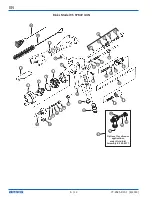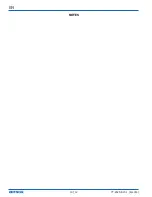
EN
77-2625-R13.1 (8/2014)
4 / 12
In normal operation, the wings on
the nozzle are horizontal as illus-
trated here. This provides
a vertical fan shaped pattern which
gives maxi-
mum coverage
as the gun is
moved back
and forth par-
allel to the
surface being
finished.
Spray width adjustment: Turn clock-
wise for round, counterclockwise for fan.
Fluid control screw: Turn clockwise to
decrease flow, counterclockwise to
increase flow.
As width of spray is increased, more
material must be allowed to pass through
the gun to obtain the same coverage on
the increased area.
SIPHON SPRAYING
Set atomization pressure at approximate-
ly 50 PSI for lacquer and 60 PSI for
enamel. Test spray. If the spray is too
fine, reduce the air pressure or open fluid
control screw. If the spray is too coarse,
close the fluid control screw. Adjust the
pattern width and repeat adjustment of
spray if necessary.
PRESSURE SPRAYING
After selecting correct size fluid orifice,
set fluid pressure for desired flow. Open
atomization air and test spray. If spray is
too fine, reduce air pressure. If spray is
too coarse, raise air pressure. Adjust pat-
tern width and repeat adjustment of spray.
Keeping fluid control screw in open posi-
tion will reduce fluid needle wear.
The spray pattern of
the Binks gun is variable
from round to flat with
all patterns in between.
Spray width
adjustment
Fluid
control
screw
FAULTY PATTERNS AND HOW TO CORRECT THEM
PATTERN
CAUSE
CORRECTION
Dried material around the
outside of the fluid nozzle tip
at position “C” restricts the
passage of atomizing air at
one point through the center
opening of air nozzle and
results in pattern shown.
This pattern can also be caused
by a loose air nozzle.
Dried material in side-port
“A” restricts passage of air.
Greater flow of air from
cleaner side-port “B” forces
fan pattern in direction of
clogged side.
Dissolve material in side-ports with thinner,
then blow gun clean. Do not poke into
openings with metal instruments.
Remove air nozzle and wipe off fluid tip
using rag wet with thinner. Tighten air
nozzle.
A split spray or one that is heavy on each
end of a fan pattern and weak in the mid-
dle is usually caused by:
(1) Too high an atomization air pressure
(2) Attempting to get too wide a spray pat-
tern with thin material.
Reducing air pressure will correct cause (1).
To correct cause (2), open material control
to full position by turning to left. At the
same time, turn spray width adjustment to
right. This will reduce width of spray, but
will correct split spray pattern.
(1) Dried out packing around material nee-
dle valve permits air to get into fluid
passageway. This results in spitting.
(2) Dirt between fluid nozzle seat and
body or loosely installed fluid nozzle
will make gun spit.
(3) A loose or defective swivel nut on
siphon cup or material hose can cause
spitting.
To correct cause (1) back
up knurled nut (E), place
two drops of machine oil
on packing, replace nut
and tighten with fingers
only. In aggravated cases,
replace packing.
To correct cause (2), remove fluid nozzle (F),
clean back of nozzle and nozzle seat in gun
body using rag wet with thinner, replace
nozzle and draw up tightly against body.
To correct cause (3), tighten or replace
swivel nut.
E
F
G
Содержание 95
Страница 10: ...EN 77 2625 R13 1 8 2014 10 12 NOTES ...
Страница 11: ...EN 77 2625 R13 1 8 2014 11 12 NOTES ...






























